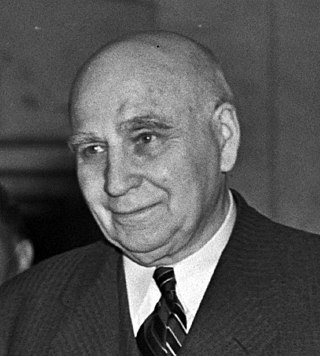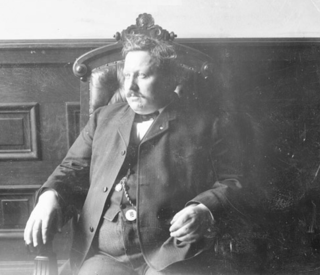Related Research Articles

The International Brotherhood of Teamsters (IBT), also known as the Teamsters Union, is a labor union in the United States and Canada. Formed in 1903 by the merger of The Team Drivers International Union and The Teamsters National Union, the union now represents a diverse membership of blue-collar and professional workers in both the public and private sectors, totalling about 1.3 million in 2015. Formerly called the International Brotherhood of Teamsters, Chauffeurs, Warehousemen and Helpers of America, the IBT is a member of the Strategic Organizing Center and Canadian Labour Congress.
Farrell Dobbs was an American Trotskyist, trade unionist, politician, and historian.
The textile workers' strike of 1934 was the largest strike in the labor history of the United States at the time, involving 400,000 textile workers from New England, the Mid-Atlantic states and the U.S. Southern states, lasting twenty-two days.

Frank Finley Merriam was an American Republican politician who served as the 28th governor of California from June 2, 1934 until January 2, 1939. Assuming the governorship at the height of the Great Depression following the death of Governor James Rolph, Merriam defeated the Democratic candidate Upton Sinclair in the California gubernatorial election in 1934. Merriam also served as the State Auditor of Iowa from 1900 to 1903, and served in both the Iowa and California state legislatures.
Union violence is violence committed by unions or union members during labor disputes. When union violence has occurred, it has frequently been in the context of industrial unrest. Violence has ranged from isolated acts by individuals to wider campaigns of organized violence aimed at furthering union goals within an industrial dispute.

The 1934 West Coast Waterfront Strike lasted 83 days, and began on May 9, 1934 when longshoremen in every US West Coast port walked out. Organized by the International Longshore and Warehouse Union (ILWU), the strike peaked with the death of two workers on "Bloody Thursday" and the San Francisco General Strike which stopped all work in the major port city for four days and led ultimately to the settlement of the West Coast Longshoremen's Strike.

The Minneapolis general strike of 1934 grew out of a strike by Teamsters against most of the trucking companies operating in Minneapolis, the major distribution center for the Upper Midwest. The strike began on May 16, 1934 in the Market District. The worst single day was Friday, July 20, called "Bloody Friday", when police shot at strikers in a downtown truck battle, killing two and injuring 67. Ensuing violence lasted periodically throughout the summer. The strike was formally ended on August 22.

Daniel Joseph Tobin was an American labor leader and president of the International Brotherhood of Teamsters from 1907 to 1952. From 1917 to 1928, he was treasurer of the American Federation of Labor. He served on the federation's Executive Council beginning in 1934, and served until his resignation in 1952.
Hollywood Black Friday, or Hollywood Bloody Friday, is the name given, in the history of organized labor in the United States, to October 5, 1945. On that date, a six-month strike by the set decorators represented by the Conference of Studio Unions (CSU) boiled over into a bloody riot at the gates of Warner Bros.' studios in Burbank, California. The strikes helped the passage of the Taft–Hartley Act in 1947 and led to the eventual breakup of the CSU and reorganization of the rival International Alliance of Theatrical Stage Employees (IATSE) leadership.
The Toledo Auto-Lite strike was a strike by a federal labor union of the American Federation of Labor (AFL) against the Electric Auto-Lite company of Toledo, Ohio, from April 12 to June 3, 1934.
The 1905 Chicago Teamsters' strike was a sympathy strike and lockout by the United Brotherhood of Teamsters in the summer of 1905 in the city of Chicago, Illinois. The strike was initiated by a small clothing workers' union. But it soon spread as nearly every union in the city, including the Teamsters, supported the job action with sympathy strikes. Initially, the strike was aimed at the Montgomery Ward department store, but it affected almost every employer in the metropolitan region after the Teamsters walked out. The strike eventually pitted the Teamsters against the Employers' Association of Chicago, a broad coalition of business owners formed a few years earlier to oppose unionization in Chicago.

Cornelius P. Shea was an American labor leader and organized crime figure. He was the founding president of the International Brotherhood of Teamsters, holding the position from 1903 until 1907. He became involved with the Chicago Outfit, and although he was indicted many times, he usually escaped conviction. After a short prison term for attempted murder removed him from union affairs, Shea was appointed secretary-treasurer of the Mafia-dominated Theatrical Janitors' Union in Chicago.

Floyd Bjørnstjerne "Skipper" Olson was an American politician and lawyer. He served as the 22nd Governor of Minnesota from January 6, 1931, to August 22, 1936, dying in office of stomach cancer. Olson was a member of the Minnesota Farmer–Labor Party, and the first member of that party to win the office of governor. He was a prominent governor of Minnesota and an influential American politician.

The Oakland general strike took place on December 3, 1946, in Oakland, California. The strike followed an earlier strike by 400 female employees of Hastings and Kahn's, who had walked out in the fall of 1946 because of the resistance Oakland's retail merchants had to unionization.
When union violence has occurred, it has frequently been in the context of industrial unrest. Violence has ranged from isolated acts by individuals to wider campaigns of organised violence aimed at furthering union goals within an industrial dispute.
The 2021 Hunts Point Produce Market strike was a labor strike involving workers for Hunts Point Produce Market in the Hunts Point neighborhood of the Bronx, New York City. The strike was carried out by about 1,400 members of Teamsters Local 202, all "produce handlers and delivery drivers" according to The Wall Street Journal. An agreement to end the strike was reached on January 23, 2021.

The 2021–2023 Warrior Met Coal strike is an ongoing labor strike in Alabama, United States. The strike began on April 1, 2021 and involves members of the United Mine Workers of America striking against Warrior Met Coal Inc. Warrior Met was formed after the bankruptcy of Walter Energy and operates coal mining facilities in the state. The strike is over the failure of the union and company to agree to a labor contract for the approximately 1,100 union members who work for Warrior Met.
The 1985–1987 Watsonville Cannery strike was a labor strike that involved over 1,000 workers at two food processing facilities in Watsonville, California, United States. The facilities were owned by Watsonville Canning and Richard A. Shaw Inc., two of the largest frozen food processors in the United States, while the workers were all union members of the International Brotherhood of Teamsters (IBT) Local 912. The strike began on September 9, 1985, and completely ended about 18 months later, on March 11, 1987.
The 1959 United Mine Workers strike was a labor action by union miners in Eastern Kentucky. Originally over a pay increase, it grew into a conflict between union and non-union mines that resulted in three deaths. It was the first instance of labor violence in the area since the Harlan County War and was the prelude to the Roving Picket Movement.
References
- 1 2 Ahern, Kelly (June 21, 2007). "To counter annual celebration of 1934 Teamsters victory, business leaders conceived the Minneapolis Aquatennial". Minneapolis Regional Labor Federation. Retrieved 19 March 2023.
- 1 2 3 Nathanson, Iric (November 20, 2010). Minneapolis in the Twentieth Century: The Growth of an American City. Minnesota Historical Society. ISBN 9780873517256 – via Google Books.
- ↑ "Remembering the truckers strike of 1934". MinnPost. July 22, 2008.
- ↑ "Second Annual 544 Picnic Sunday" (PDF). The Northwest Organizer. No. 18 (Vol. 3). August 19, 1937. Retrieved 19 March 2023.
- ↑ "Aquatennial: The Ultimate Summer Block Party". Mpls St Paul Mag. July 22, 2019. Retrieved 19 March 2023.
- ↑ "After being axed, the popular milk carton boat race returns to Minneapolis". Star Tribune. May 3, 2017. Retrieved 19 March 2023.